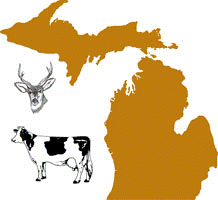Wildlife Disease and Zoonotics
Date of this Version
10-2009
Abstract
Deer are acknowledged as hosts of Mycobacterium bovis, the causative agent of bovine tuberculosis (bTB), and determining the prevalence of infection in deer species is one of the key steps in understanding the epidemiological role played by cervids in the transmission and maintenance of bTB in the United Kingdom. This study evaluated a rapid lateral-flow test for the detection of bTB in samples from wild deer species in the United Kingdom. Fallow deer (Dama dama), roe deer (Capreolus capreolus), and red deer (Cervus elaphus) from areas in Wales, the Cotswolds, and southwestern England were necropsied for a bTB survey. Serum samples from individual deer were tested with the CervidTB STAT-PAK, and the results were evaluated against the culture of M. bovis from tissues (n = 432). Sensitivity and specificity were 85.7% (95% confidence interval [CI], 42.1 to 99.6%) and 94.8% (95% CI, 92.3 to 96.7%), respectively, with an odds ratio of 109.9 (95% CI, 12.7 to 953.6%) for a positive STAT-PAK result among culture-positive deer. The low prevalence of infection (3.8%, n = 860) affected the confidence of the sensitivity estimate of the test, but all culture-positive fallow deer (n= 6) were detected by the test. In addition, antibodies to M. bovis could be detected in poor-quality serum samples. The results suggest that the CervidTB STAT-PAK could be deployed as a field test for further evaluation.



Comments
Published in CLINICAL AND VACCINE IMMUNOLOGY, Oct. 2009, p. 1449–1452 Vol. 16, No. 10.